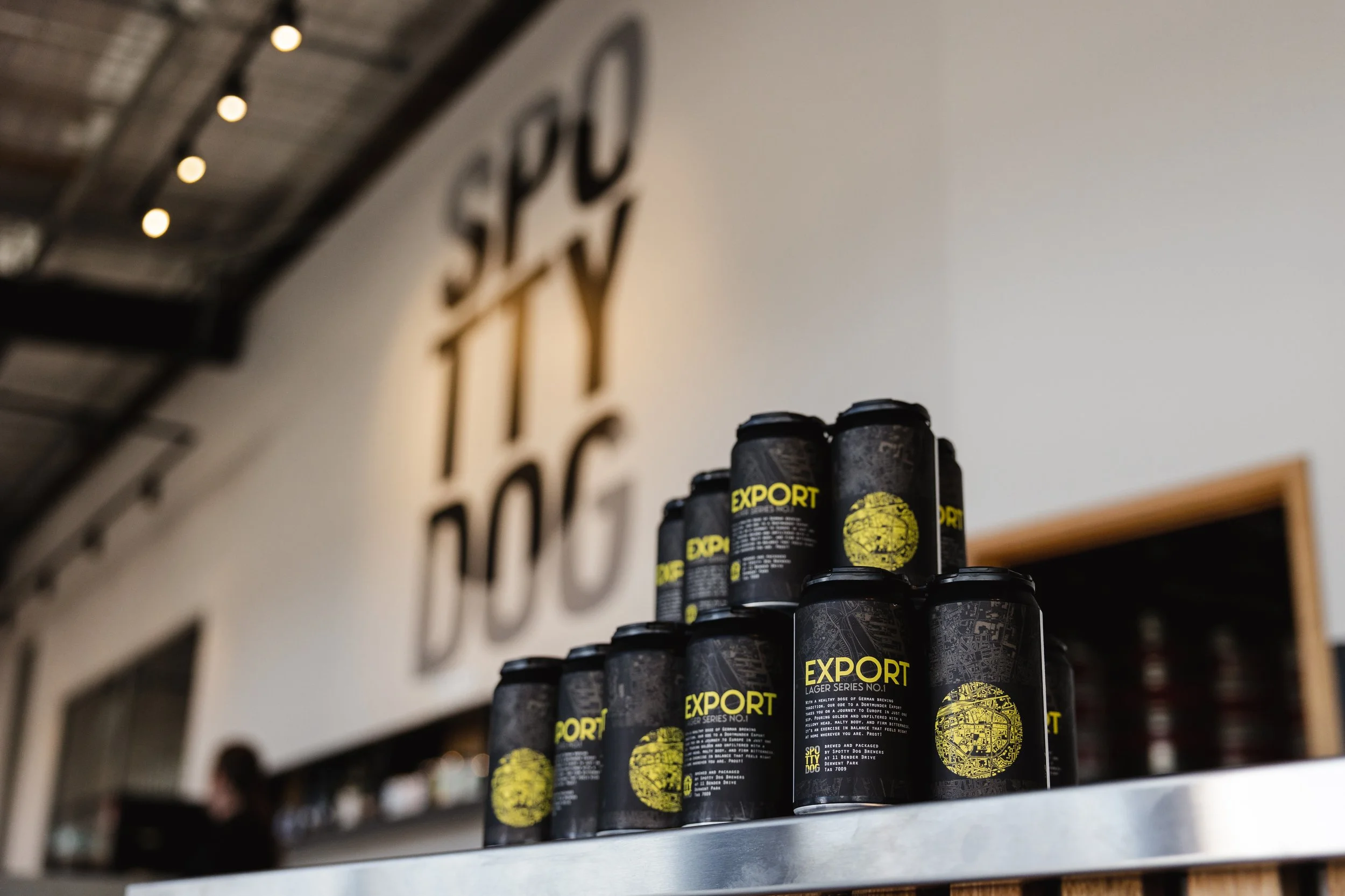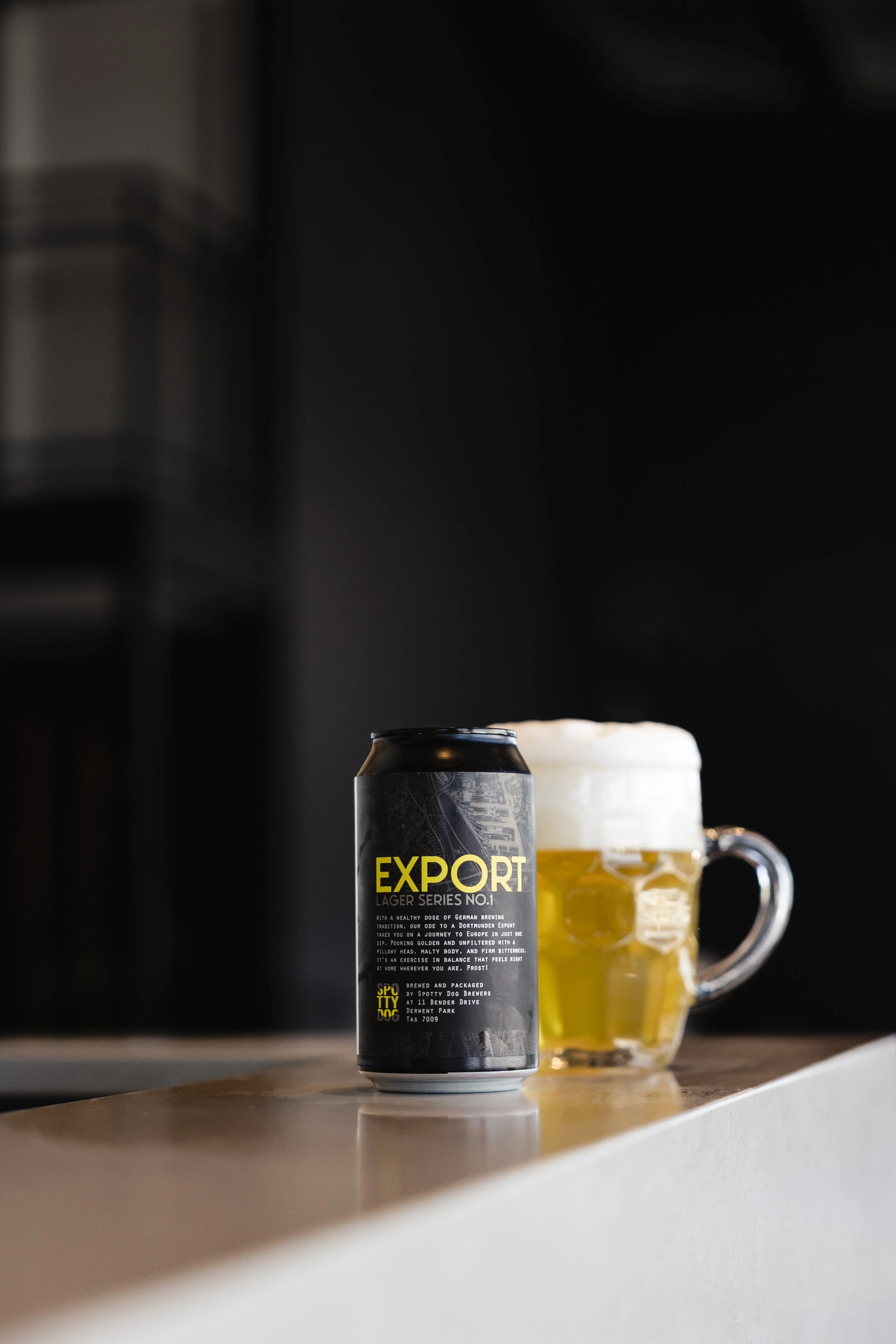Export Lager
By now you’ve hopefully tasted Spotty’s first lager! Our core range lager, Export, has been around a few months now after a quite a few solid months of R&D at our new brewery down at Prince of Wales Bay. But what even is Export? Well, settle in, crack a cold one, and I’ll fill you in…
Export as a style comes from industrial revolution Germany, Dortmund to be precise. This should tell you a couple of things right away: it’s an old school euro lager, so it should have an old school euro flavour (which, with our goal of using 100% Aussie ingredients on this brew, was a challenge I’ll get to in a moment) and it’s German - they have a pretty serious tradition concerning process and ingredients. Luckily for us, we have a fairly nifty new brewhouse down at the bay and we can accommodate most of that process, the key part being a step mash. Wait, “what’s a step mash?”, I hear you ask. Well, without getting too technical, beer starts life as fancy porridge, called mash: malted (1) grain and water are mixed together (“mashed in”) at one temperature, generally somewhere between 62º and 67º. At this temperature naturally occurring enzymes (2) break the starches in the grain into smaller sugars that now taste sweet. This single temperature step (3) is fine for most beers, but lagers in general, and old euro lagers in particular, benefit from a range of temperatures where different enzymes are activated, not just the ones that produce sugar but also enzymes which affect proteins, which happens closer to 50º. Running your mash through multiple temperature steps, or in other words step mashing (4) thus gives your beer a richer, more complex malt flavour and mouthfeel (very important when you’re less reliant on hops for flavour) as well as affecting the head production and retention, leading to those thicc foam pillows on a Stein in the Biergarten we all love so much.
Step mashing, especially the kind we practise, is very intense on the malt. Proteins and sugars all get broken down to extreme levels which can have a whole range of ill effects if you let it go too far. This leads me neatly into ingredients. Most modern malt is what we call highly modified, which means a huge amount of the work on the proteins and sugars has already been done for the brewer by the maltster making the malt, in their own processes. Mash this too intensely and you’ll end up with watery, insipid beer with no head. Yum. To get around this we had to find malt more reminiscent of traditional european malt, and thankfully our mates at Voyager had exactly what we needed: Undermodified Pilsner Malt. In other words, malt which is deliberately slightly less modified than usual, allowing us to step mash and get those complex malt flavours into our beer while keeping a rich head and mouthfeel. They’re also the only maltster producing that traditional style of malt in Australia (5). Without them, we wouldn’t have been able to keep the ingredients in our lager 100% Aussie, so thanks Voyager!
After we figured out the malt, our next challenge was hops. Aussie hops are notoriously tropical in flavour and aroma but we didn’t want to make a new world lager, all fruity and strange, we wanted something with a classic euro flavour. We needed something with noble (6) character if we were going to properly pay homage to that classic euro experience. Again, there are plenty of options if you want to import hops but with our goal of 100% Aussie ingredients we were limited to what was locally available. Happily, just down the road from us here is the Hop Products Australia head office and in the other direction are quite a few of their hop fields. Working with them, we settled on a blend of locally produced hops which, when used early in the process, give a noble character, spicy and herbal with none of the tropical nonsense more befitting a hazy. We were finally getting somewhere! Now we just had to find some yeast (7).
Before we get into yeast, let’s take a second to look at ales vs lagers. It’s common to refer to these as styles of beer but really they’re categories and ill defined ones at that. Broadly speaking, these two types of beer are distinguished by their fermentation temperature. Ales are fermented warm (8) while lagers are fermented cold (9). Each category has associated strains of yeast that work best at those temperatures, but it’s possible, depending on what characters you’re going for in your beer, that you can ferment a lager with an ale yeast that operates well in the cold and vice versa. In fact, this is one of the things we played with when we were doing R&D for our Export. None of this would have been possible without Bluestone Yeast, with a lab and production facility just across the water in Melbourne, completing the last piece of the puzzle. Euro lager with 100% Aussie ingredients? Done!
Now that we’ve got past the how, let’s get to the what I promised earlier. We’re here to learn about Export, after all. To answer that question we need to take a step back again and understand exactly what lager is - it’s more than just a fermentation temperature. So what do we mean when we talk about lager? And what the hell is “old school euro lager”?
If you’ve made it this far it’s probably time for another beer, so go grab one and we can dig in.
Modern lager probably evolved from brewing tradition in the area around Plzeň (10). That original lager became, over time, a very specific beer, Světlé Pivo, which in Czech means “light beer” (11). That beer is distinguished by the pungent herbal tang of Saaz hops with a lean malt backbone, occasionally with a slight butteryness from diacetyl buildup during fermentation, and that beer is also what became known as Czech Pilsner outside of the Czech Republic. Pilsner has since become almost synonymous with lager in most usage and you’ll hear the terms used interchangeably by an awful lot of people. It’s important to remember though, Pilsner is a style of lager, while lager is a category of beer. All pilsners are lagers but not all lagers are pilsners, and Czech Pilsner especially should only be used for the beers emulating beers from Plzeň, in other words Czech Světlé Pivo (12).
Where did all these other lagers come from then? From its debut, Pilsner was incredibly successful and it found a home in each new market it was brought to (13), which led to breweries across Europe adopting and modifying the style to the tastes of their local market. In München for example, it became Helles (that also means “light”): significantly less bitter than its parent beer and more reliant on malt for flavour. In Dortmund it became Export: light golden in colour with a bready, straw like, slightly sweet malt profile balanced (14) against a hefty bitterness. This became immensely popular with the workers of the booming coal and steel industries in the region, and pretty soon this style was exported (15) to other cities nearby.
Why Export then? Better still, why lager, and why now? Well, because we needed too. As great as ales are, for years now, when we’ve sat down for a beer with mates it’s euro imports we’ve been reaching for. Partly to remind us of travel and good times, but mostly because they go down like nothing else: crisp, refreshing and moreish in a way that the latest hazy IPA just isn’t. Very few Aussie lagers match that feeling - even less still are made with the abundance of amazing produce we have right at our doorstep. Export was just the natural fit: for our palate, for our climate, for our brewhouse and for a concept: exported first from Germany, and soon exported from Tasmania across the whole of Australia.
Cheers,
Rhyley
Head Brewer
Notes:
Grain that’s been germinated and then dried.
Proteins that bring on chemical reactions. I might’ve lied about not getting technical. Stick with me.
See where I’m going yet?
We got there in the end!
That we know of.
A word I’ve always found a bit pretentious, but it describes the flavour of old European hops: spicy, herbal, vegetal, classic.
Well, I should talk about water, but it’s always the first thing to be ignored as it’s so chemically complex while also being criminally uninteresting. Suffice to say soft, mineral poor water is what you need for brewing clean lager and that’s exactly what comes out of the tap in Hobart. We do filter it, but that’s about it.
Above about 15O, but I’m sure a different brewer would give you a different number.
From 15O down to about 8O or so, depending on the yeast strain and character you’re going for.
Look familiar? That’s where our word Pilsner comes from.
Light in colour, but often depending on the brewery or beer, comparatively light in alcohol too at around 4%.
Other types of Pilsner arguably exist, for example the German Pilsners that are so in vogue at the moment, but even these are more commonly referred to as Pils in their home country. English complicates everything by using Pilsner for all of them, further muddying the distinction.
Mostly European cities to start; this was the 1800s and horses are pretty slow.
In fact this balance is probably the distinguishing feature of Export: malt and hops shine equally.
The big reveal! Aren’t you glad you made it to the end!?
Photo credit: Lochie Bevis

